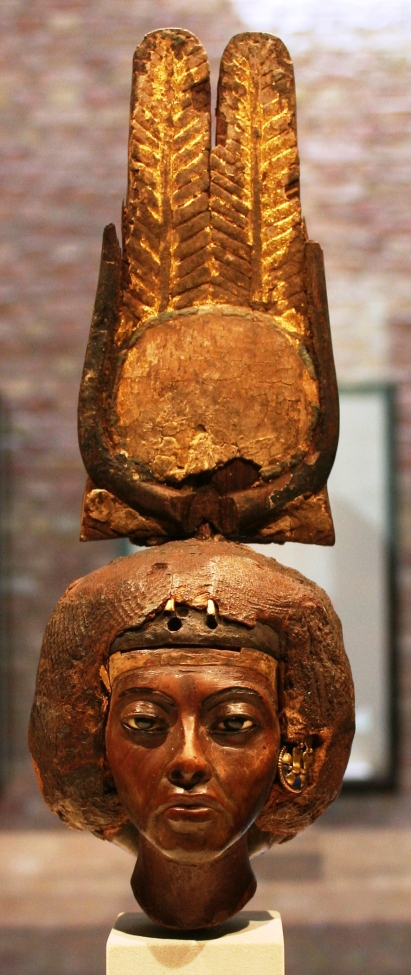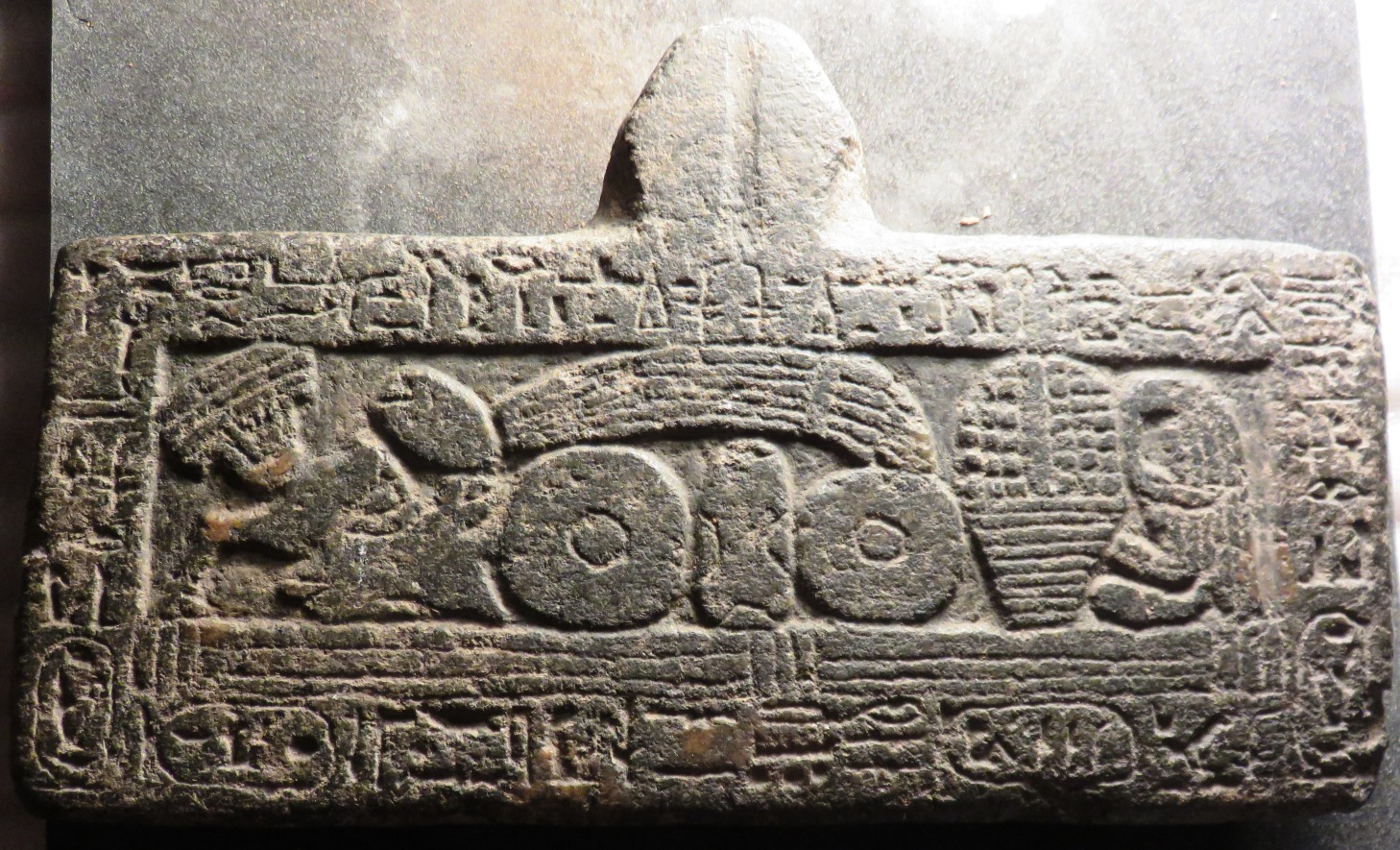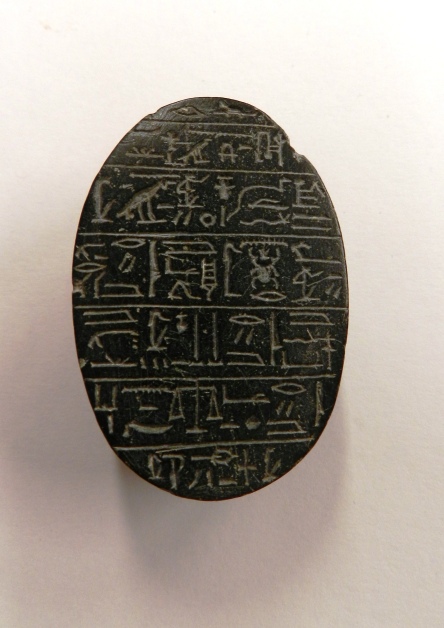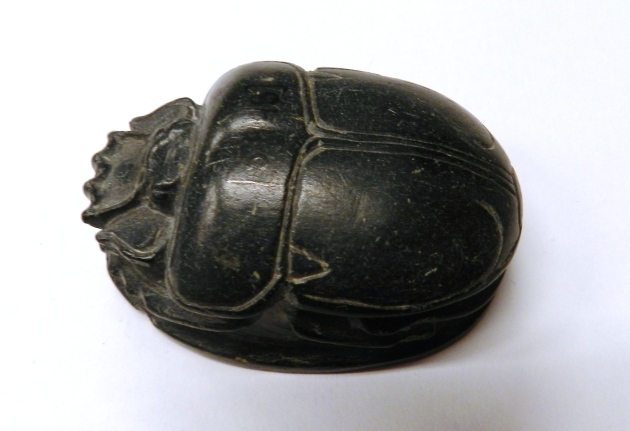Egyptian
Greco-Roman Period
332 B.C.–A.D. 337
Dimensions
height x width x length (height including base): 3.1 x 1.7 x 7.7 cm (1 1/4 x 11/16 x 3 1/16 in.)
Faience ithyphallic male and female in an erotic pose. The male is missing the head. The faience is blue glazed. They are standing on a base. The surface of the base is chipped in the corner.
Met museum
Metmuseum.org
sábado, 31 de octubre de 2015
viernes, 30 de octubre de 2015
MULTIPLE VASE
MULTIPLE VASE
NAQADA II
Beginning in the middle of the Naqada II Period, the Egyptians used fossil marl clay for the manufacture of decorated pottery. This clay comes from the deserts and makes objects made from it much more solid. The pottery is distinguished by violet-black decoration on a rose-yellow base and by the introduction of new designs: the principal subjects are rowing boars, women with raised arms (identical with figures in the round such as Brussels E.3006), animals, and plants. They are placed in a landscape in which water and the mountains play a significant role. On this double vessel rowing boats on the Nile can be seen, the water being indicated by undulating lines.
KMKG - MRAH
globalegyptianmuseum
Comb,
Comb, Predynastic Period, ca. 3200 B.C.
Egyptian
Ivory; H. 2 1/4 in. (5.7 cm)
Theodore M. Davis Collection, Bequest of Theodore M. Davis, 1915 (30.8.224)
Finely carved ivory combs and knife handles produced toward the end of Egypt's prehistory demonstrate the high standards Egyptian artists had achieved, even before the Old Kingdom. This comb may have been part of the funeral equipment of an elite person who lived about 5,200 years ago. Parts of the comb's teeth, now missing, can be seen along the bottom edge. The detailed decoration suggests that it was a ceremonial object, not just an instrument for arranging the hair. On both sides are figures of animals in horizontal rows, a spatial organization familiar from later Egyptian art. The animals include elephants and snakes; wading birds and a giraffe; hyenas; cattle; and perhaps boars. Similar arrangements of these creatures on other carved ivory implements suggest that the arrangement and choice of animals were not haphazard. Elephants treading on snakes suggest that this part of the scene was symbolic. The mythologies of many African peoples associate elephants and serpents with the creation of the universe. The uppermost row of this comb may symbolize a creative deity to whom the rest of the animals owe their existence.
Met Museum
metmuseum.org
Egyptian
Ivory; H. 2 1/4 in. (5.7 cm)
Theodore M. Davis Collection, Bequest of Theodore M. Davis, 1915 (30.8.224)
Finely carved ivory combs and knife handles produced toward the end of Egypt's prehistory demonstrate the high standards Egyptian artists had achieved, even before the Old Kingdom. This comb may have been part of the funeral equipment of an elite person who lived about 5,200 years ago. Parts of the comb's teeth, now missing, can be seen along the bottom edge. The detailed decoration suggests that it was a ceremonial object, not just an instrument for arranging the hair. On both sides are figures of animals in horizontal rows, a spatial organization familiar from later Egyptian art. The animals include elephants and snakes; wading birds and a giraffe; hyenas; cattle; and perhaps boars. Similar arrangements of these creatures on other carved ivory implements suggest that the arrangement and choice of animals were not haphazard. Elephants treading on snakes suggest that this part of the scene was symbolic. The mythologies of many African peoples associate elephants and serpents with the creation of the universe. The uppermost row of this comb may symbolize a creative deity to whom the rest of the animals owe their existence.
Met Museum
metmuseum.org
POTTERY
POTTERY
NEW KINGDOM: 18TH DYNASTY: AMENHOTEP II/AMENOPHIS II/AAKHEPERURE
nTr*nfr-nb:N19-ra-aA-xpr-Z2-Q2-ir-A40-mr-M17A-mAa-xrw\r3-
The good god, Lord of the Two Lands, "Aa-Kheperu-Re", beloved of Osiris, true of voice
KMKG - MRAH
globalegyptianmuseum
NEW KINGDOM: 18TH DYNASTY: AMENHOTEP II/AMENOPHIS II/AAKHEPERURE
nTr*nfr-nb:N19-ra-aA-xpr-Z2-Q2-ir-A40-mr-M17A-mAa-xrw\r3-
The good god, Lord of the Two Lands, "Aa-Kheperu-Re", beloved of Osiris, true of voice
KMKG - MRAH
globalegyptianmuseum
The Egyptian Book of Gates
The Egyptian Book of Gates is the second large Pharaonic Book of the Afterlife after The Egyptian Amduat. The revised English translation is based on the German edition, edited by Erik Hornung. The hieroglyphs and transcriptions are given on the basis of a collation of the extant texts found in different tombs. The main illustrations of the text come from the sarcophagus of Seti I. The one hundred scenes of The Book of Gates are furthermore represented with one or more colored illustrations, originating from different sources
ISBN-13: 978-3952388051
ISBN-10: 395238805X
ISBN-13: 978-3952388051
ISBN-10: 395238805X
Nude female figurine
Terracotta: AN1910.697
Object: Nude female figurine
Period: Bronze Age: Early Bronze Age
Dimensions: H: 9.7cm.
Region: Anatolia
Find Spot: no provenance
Description: seated; handmodelled; baked; coarse buff fabric with a burnished red slip, worn off on the flat base; two holes are pierced in the lower back and one in the centre of the base; the slightly damaged face was applied as a disk, tipped back so that the chin projects, on the front of the head; the eyebrows and nose are a continuous projecting ridge; the eyes are deep-punched holes in incised oval frames; the mouth is an incised slit with vertical incisions below on the chin ("beard"); the ears and what was originally a major protrusion ("polos"); on the head are broken off; the upper body is flattened, with triangular shape accentuated by projecting shoulders; attenuated arms extended down either side of the body with the hands grasping the knees; incised lines on the upper arms and shoulders; incised crossing straps and what may be a necklace; pointed breasts with incised nipples; genitals represented by an incised rectangular with incised dots inside it; short lower body with stump legs.
Reference: Moorey (2004) 383
Ashmolean Museum
ahsmolean.org
Object: Nude female figurine
Period: Bronze Age: Early Bronze Age
Dimensions: H: 9.7cm.
Region: Anatolia
Find Spot: no provenance
Description: seated; handmodelled; baked; coarse buff fabric with a burnished red slip, worn off on the flat base; two holes are pierced in the lower back and one in the centre of the base; the slightly damaged face was applied as a disk, tipped back so that the chin projects, on the front of the head; the eyebrows and nose are a continuous projecting ridge; the eyes are deep-punched holes in incised oval frames; the mouth is an incised slit with vertical incisions below on the chin ("beard"); the ears and what was originally a major protrusion ("polos"); on the head are broken off; the upper body is flattened, with triangular shape accentuated by projecting shoulders; attenuated arms extended down either side of the body with the hands grasping the knees; incised lines on the upper arms and shoulders; incised crossing straps and what may be a necklace; pointed breasts with incised nipples; genitals represented by an incised rectangular with incised dots inside it; short lower body with stump legs.
Reference: Moorey (2004) 383
Ashmolean Museum
ahsmolean.org
Tomb TT335
Tomb TT335 of the sculptor Nakhtamon was discovered by Bernard Bruyère on January 16th, 1925, just to the south of TT336, of his brother Neferrenpet and to the north of the one of his brother-in-law Qen, TT4.
The picture of the couple is very beautiful showing a great amount of detail. The image of this young woman, clearly shows her long curly tripartite wig with twisted braids of hair extending much further than the main part. The wig is fastened at the top by a band from which projects, at the front, a lotus flower button
osirisnet. net
The picture of the couple is very beautiful showing a great amount of detail. The image of this young woman, clearly shows her long curly tripartite wig with twisted braids of hair extending much further than the main part. The wig is fastened at the top by a band from which projects, at the front, a lotus flower button
osirisnet. net
Figure of a girl
Figure of a girl with a cat and standing figure of a young woman, 18th Dynasty, c. 1380 and 19. Dynasty, Abusir el Meleq and Theben
Tomb of Hapuseneb TT67
Tomb of Hapuseneb TT67
http://www.maat-ka-ra.de
According to N M. Davies (1961) the scene a position 3 shows craftsmen, evidently chariot-makers. The upper register shows craftsmen cutting and bending wood or leather, most likely controlled by an overseer standing on the right. The register below shows another man doing similar work. The following pictures shows the corresponding frawing by Davis
Hapuseneb
statua – Nuovo Regno: XVIII dinastia, regno di Hatscepsut (1479-1458 a.C.)
Hapuseneb fu un funzionario importante alla corte della regina Hatshepsut (1479-1458 a.C.), ricoprendo il ruolo di visir e di primo profeta di Amon; di lui sono noti molti monumenti fra cui un cenotafio a Gebel el Silsila e la tomba a Tebe, da cui proviene probabilmente anche questa statua che lo mostra seduto su un seggio dal basso schienale e con i piedi in appoggio su un alto zoccolo. Il mantello che avvolge il corpo, incrociandosi a V all’altezza del petto e lasciando scoperta solo la mano sinistra, crea un’ampia superficie dai profili morbidi in contrasto alla geometrica semplicità del sedile. La lunga iscrizione incisa su tre lati del seggio in fitte colonne verticali di geroglifici a incavo poco profondo e con tracce di colore blu tramanda parte della titolatura di Hapuseneb, alcune note biografiche e la tipica formula per l’offerta funeraria. Un’unica colonna di testo incisa sul corpo, in posizione frontale tra la vita e i piedi, presenta ampie lacune in corrispondenza del nome di Hapuseneb e di suo padre, ma può essere facilmente integrata come segue: “Il nobile, il principe, il cancelliere del re del Basso Egitto, il primo profeta di Amon [Hapuseneb, giustificato (dal tribunale ultraterreno di Osiri), nato dal dignitario Hapu, giustificato], generato dalla [concubina] regale Iahhotep, giustificata.”. Questa erasione, così come la mancanza della testa della statua, di cui è visibile solo una piccola parte della parrucca, potrebbe essere attribuibile alla damnatio memoriae che colpì la regina Hatshepsut e alcuni suoi fidati funzionari durante il regno del suo successore Thutmosis III (1479-1426 a.C.) e ancora di più in età ramesside.
Informazioni
Provenienza:
Materiale: Calcare dipinto
Dimensioni: Altezza: 93 cm - Larghezza: 33 cm
Numero di inventario: MCA-EGI-EG_1822
Biografia: Museo Civico di Bologna. Catalogo di Antichità Egizie descritte dal prof. cav. Giovanni Kminek-Szedlo, Torino, 1895, n. 1822; Curto, Silvio, L’Egitto antico nelle collezioni dell’Italia settentrionale, Bologna, 1961, n. 22; Pernigotti, Sergio, La statuaria egiziana nel Museo Civico Archeologico di Bologna, Bologna, 1980, n. 6; Il senso dell’arte nell’antico Egitto, Milano, 1990, n. 34; Morigi Govi, Cristiana, La collezione egiziana, Milano, 1994, p. 66.
http://informa.comune.bologna.it
Hapuseneb fu un funzionario importante alla corte della regina Hatshepsut (1479-1458 a.C.), ricoprendo il ruolo di visir e di primo profeta di Amon; di lui sono noti molti monumenti fra cui un cenotafio a Gebel el Silsila e la tomba a Tebe, da cui proviene probabilmente anche questa statua che lo mostra seduto su un seggio dal basso schienale e con i piedi in appoggio su un alto zoccolo. Il mantello che avvolge il corpo, incrociandosi a V all’altezza del petto e lasciando scoperta solo la mano sinistra, crea un’ampia superficie dai profili morbidi in contrasto alla geometrica semplicità del sedile. La lunga iscrizione incisa su tre lati del seggio in fitte colonne verticali di geroglifici a incavo poco profondo e con tracce di colore blu tramanda parte della titolatura di Hapuseneb, alcune note biografiche e la tipica formula per l’offerta funeraria. Un’unica colonna di testo incisa sul corpo, in posizione frontale tra la vita e i piedi, presenta ampie lacune in corrispondenza del nome di Hapuseneb e di suo padre, ma può essere facilmente integrata come segue: “Il nobile, il principe, il cancelliere del re del Basso Egitto, il primo profeta di Amon [Hapuseneb, giustificato (dal tribunale ultraterreno di Osiri), nato dal dignitario Hapu, giustificato], generato dalla [concubina] regale Iahhotep, giustificata.”. Questa erasione, così come la mancanza della testa della statua, di cui è visibile solo una piccola parte della parrucca, potrebbe essere attribuibile alla damnatio memoriae che colpì la regina Hatshepsut e alcuni suoi fidati funzionari durante il regno del suo successore Thutmosis III (1479-1426 a.C.) e ancora di più in età ramesside.
Informazioni
Provenienza:
Materiale: Calcare dipinto
Dimensioni: Altezza: 93 cm - Larghezza: 33 cm
Numero di inventario: MCA-EGI-EG_1822
Biografia: Museo Civico di Bologna. Catalogo di Antichità Egizie descritte dal prof. cav. Giovanni Kminek-Szedlo, Torino, 1895, n. 1822; Curto, Silvio, L’Egitto antico nelle collezioni dell’Italia settentrionale, Bologna, 1961, n. 22; Pernigotti, Sergio, La statuaria egiziana nel Museo Civico Archeologico di Bologna, Bologna, 1980, n. 6; Il senso dell’arte nell’antico Egitto, Milano, 1990, n. 34; Morigi Govi, Cristiana, La collezione egiziana, Milano, 1994, p. 66.
http://informa.comune.bologna.it
Household Archaeology in Complex Societies
OIS 10. Household Studies in Complex Societies: (Micro) Archaeological and Textual Approaches
coverEdited by Miriam Müller
jueves, 29 de octubre de 2015
TT127, the tomb of Senemiah , and later of Piay and his son Pairy
Hunting waterfowl with the help of nets, is a scene, which in a tomb of the old kingdom would not be out of place. On the right of the papyrus undergrowth can be seen to emerge the head of the master of the hunt, who gives the order to the men to pull on the rope to close the net in which a great many birds are to be trapped (see gm-45). Two things are unusual: the first is the presence of a man, other one than the tomb owner, who gets ready to propel a throwing stick at the fowl which are attempting to escape. In his other hand, this man holds a second stick (in reserve) to his shoulder. The second is the presence of three more men pulling the rope, all having a triangular beard which gives them the air of being Asiatic.
TT127, the tomb of Senemiah
 , and later of Piay
, and later of Piay  and his son Pairy
and his son Pairy 
martes, 27 de octubre de 2015
Slender vessel of stone
Slender vessel of stone with heavy veining. It has a high centre of gravity with steep shoulders on which are very small suspension handles.
KUNSTHISTORISCHES MUSEUM
globalegyptianmuseum
KUNSTHISTORISCHES MUSEUM
globalegyptianmuseum
vessel
Vessel, Predynastic Period, Naqada II, ca. 3450–3300 b.c.
Egyptian
Painted pottery; H. 11 3/4 in. (29.8 cm)
Rogers Fund, 1920 (20.2.10)
The images on this vessel represent important social or religious events, the precise significance of which is not perfectly understood. Two male and two female figures stand aboard a boat, which is depicted with oars and two cabins. In the areas surrounding the boat are mountains, birds that may represent flamingos, plants, and water.
Met Museum
metmuseum.org
Egyptian
Painted pottery; H. 11 3/4 in. (29.8 cm)
Rogers Fund, 1920 (20.2.10)
The images on this vessel represent important social or religious events, the precise significance of which is not perfectly understood. Two male and two female figures stand aboard a boat, which is depicted with oars and two cabins. In the areas surrounding the boat are mountains, birds that may represent flamingos, plants, and water.
Met Museum
metmuseum.org
Sculptor's model with a lion in relief
Sculptor's model with a lion in relief. On its shoulder is a human ear.
PTOLEMAIC PERIOD
KUNSTHISTORISCHES MUSEUM
globalegyptianmuseum
PTOLEMAIC PERIOD
KUNSTHISTORISCHES MUSEUM
globalegyptianmuseum
lunes, 26 de octubre de 2015
Danseuse acrobatique
Danseuse acrobatique. (H : 10.5 cm - l : 16.8 cm, début de la XIX° dynastie, vers 1295 av JC). Musée de Turin. Cette danseuse, très gracieuse, vient sans doute d'effectuer une culbute. Elle est seulement vêtue d'un pagne drapé autour des hanches. Sa longue chevelure traîne par terre et touche ses pieds en refermant le cercle, mais curieusement la boucle d'oreille n'a pas suivi le mouvement descendant. Cette figure apparaît déjà au Moyen Empire dans de petites statuettes en calcaire. On ignore si cette figure a une signification cultuelle ou si elle est destinée à un spectacle de divertissement.
http://jfbradu.free.fr/egypte
http://jfbradu.free.fr/egypte
Texts in Translation #15: An offering table dedicated by Queen Tiye (Acc. no. 633)
Texts in Translation #15: An offering table dedicated by Queen Tiye (Acc. no. 633)
Like so many seemingly unassuming objects, this small (25 x 11 cm) black granite offering table carries an interesting back-story. It comes from the excavations of W.M. Flinders Petrie at the site of Gurob, the ‘harem’ complex used to house royal women and children in part of the New Kingdom (c. 1400-1200 BC). Manchester Museum holds many objects from Petrie’s excavations at Gurob, which is currently being reinvestigated by a joint project of the Universities of Liverpool, Copenhagen and UCL.
One of the most famous finds to have come from the site is a small ebony head of Queen Tiye, the chief wife of Amenhotep III (c. 1390-1352 BC), now in Berlin. It is likely that the queen spent a lot of time at Gurob, and the inscription on our offering table suggests she lived here as ‘Queen Mother’ after her husband’s death.
The hieroglyphs read:
An offering which the king gives (to) Osiris, Ruler of the West, that he may allow coming and going in Rosetau for the royal ka (of) the Osiris, Neb-maat-re;
An offering which the king gives (to) Osiris, Ruler of Eternity, that he may give all that comes out upon his altar for the royal ka of the Osiris, Neb-maat-re;
The Great Royal Wife, she made (it) as her dedication for her ‘brother’, her beloved, the perfect god, Neb-maat-re.
Petrie noted the importance of the piece when reviewing the inscribed finds from Gurob: “The black granite altar is of special interest. Though roughly cut it seems to have belonged to a class of funerary offerings made for Amenhotep III by his celebrated queen Thii. It follows the usual formulae to Osiris, for the royal ka of Amenhotep III, down each side ; and then along the base is a line stating that ” The great royal wife Thii made her monuments of her brother, her beloved, the good god Ra-ma-neb.’ The question of the parentage of Thii is one of the most important genealogies in Egyptian history.
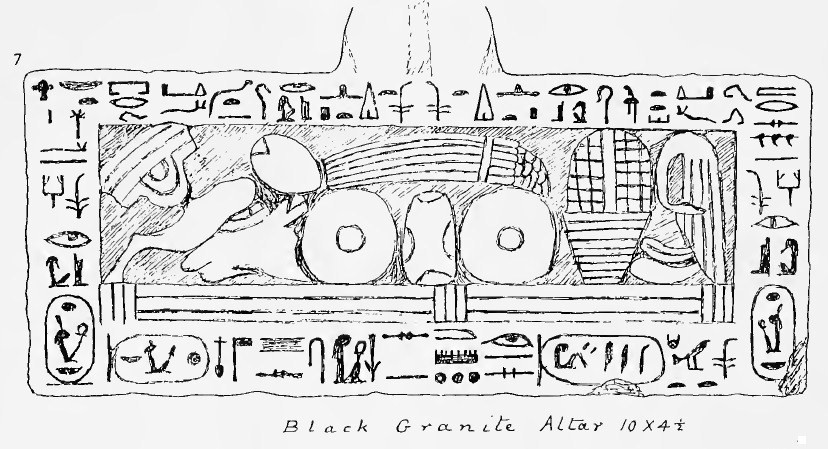
Petrie’s interest focussed on the use of the Egyptian term ‘sen’, which implies kinship but is often rendered ‘brother’. In fact, Tiye’s statement need not mean that she was the sister of Amenhotep III; a more general sense of kinship may be meant (the word “husband” – written with a phallus sign – may have been inappropriate), and the affectionate sentiment of wife towards her spouse is appealing.
The fact that the offering table exists at all and the reference to the king as ‘the Osiris’ implies that Amenhotep III had died when this object was made and used. The appearance of the term ‘royal ka’ (ka nesu) is also fairly uncommon, and refers to an important (semi-)divine aspect of the king’s person, which could be separated from him and objectified for worship. Although Amenhotep III promoted his own divinity to an unusual extent during his own lifetime, it seems more likely that the ‘royal ka’ mentioned here is that of the deceased king.
One of the most famous finds to have come from the site is a small ebony head of Queen Tiye, the chief wife of Amenhotep III (c. 1390-1352 BC), now in Berlin. It is likely that the queen spent a lot of time at Gurob, and the inscription on our offering table suggests she lived here as ‘Queen Mother’ after her husband’s death.
The hieroglyphs read:
An offering which the king gives (to) Osiris, Ruler of the West, that he may allow coming and going in Rosetau for the royal ka (of) the Osiris, Neb-maat-re;
An offering which the king gives (to) Osiris, Ruler of Eternity, that he may give all that comes out upon his altar for the royal ka of the Osiris, Neb-maat-re;
The Great Royal Wife, she made (it) as her dedication for her ‘brother’, her beloved, the perfect god, Neb-maat-re.
Petrie noted the importance of the piece when reviewing the inscribed finds from Gurob: “The black granite altar is of special interest. Though roughly cut it seems to have belonged to a class of funerary offerings made for Amenhotep III by his celebrated queen Thii. It follows the usual formulae to Osiris, for the royal ka of Amenhotep III, down each side ; and then along the base is a line stating that ” The great royal wife Thii made her monuments of her brother, her beloved, the good god Ra-ma-neb.’ The question of the parentage of Thii is one of the most important genealogies in Egyptian history.

Petrie’s interest focussed on the use of the Egyptian term ‘sen’, which implies kinship but is often rendered ‘brother’. In fact, Tiye’s statement need not mean that she was the sister of Amenhotep III; a more general sense of kinship may be meant (the word “husband” – written with a phallus sign – may have been inappropriate), and the affectionate sentiment of wife towards her spouse is appealing.
The fact that the offering table exists at all and the reference to the king as ‘the Osiris’ implies that Amenhotep III had died when this object was made and used. The appearance of the term ‘royal ka’ (ka nesu) is also fairly uncommon, and refers to an important (semi-)divine aspect of the king’s person, which could be separated from him and objectified for worship. Although Amenhotep III promoted his own divinity to an unusual extent during his own lifetime, it seems more likely that the ‘royal ka’ mentioned here is that of the deceased king.
Texts in Translation #1: The Heart Scarab of Na-her-hu (Acc. No. 5998)
Texts in Translation #1: The Heart Scarab of Na-her-hu (Acc. No. 5998)
Visitors sometimes comment that they would like to have access to translations of the hieroglyphic texts that appear on some of our Egyptian and Sudanese objects. We aim to provide these as a digital resource to complement the new Ancient Worlds galleries, and I will post them here as time – and work – allows. On a recent visit to the Museum, a group called Forever Young expressed a particular liking for this text, so it seemed a good place to start.
This spell is of a type usually carved on the underside of amulets known as Heart Scarabs. This example dates to the later New Kingdom (c. 1320-1069 BC), and belonged to a scribe named Na-her-hu. This is a shortened version of Spell (or ‘Chapter’) 30B of the Book of the Dead: slightly different versions are sometimes included in papyrus copies of the Book.
‘The Osiris, Scribe of the Mat, Na-her-hu, justified, he says: “O my heart, which I had from my mother, the centre of my being. Do not stand against me as a witness, do not oppose me in the judgement hall, in the presence of the keeper of the balance. You are my ka (spirit) in my body, the creator [who makes my limbs prosper]”.’
The Egyptians believed that in order to gain entry into the Afterlife – described as a blissful ‘Field of Reeds’ – one had to undergo judgement before the gods. During mummification, all the internal organs were removed – except the heart, which was regarded as the seat of intelligence and emotion. The righteousness of the deceased was assessed by weighing the heart on a set of scales. If it balanced with a feather, a symbol for truth, then the deceased was declared ‘justified’ and could enter the afterlife. If, however, the heart was heavier than the feather – presumably weighty with wickedness – then it was swallowed by a monster called Ammut (‘the Devourer’): part crocodile, part lion, part hippo. This was the second death that all Egyptians feared, and meant non-existence.
 As the seat of emotion, the heart was prone to be unpredictable. It might betray misdemeanours or make false claims. The deceased therefore needed to be appealed to his own heart to ensure its compliance in his rebirth. A Heart Scarab was placed within the mummy wrappings, ideally directly over the heart, to ensure both that the heart was magically protected – and that it was kept in check.
As the seat of emotion, the heart was prone to be unpredictable. It might betray misdemeanours or make false claims. The deceased therefore needed to be appealed to his own heart to ensure its compliance in his rebirth. A Heart Scarab was placed within the mummy wrappings, ideally directly over the heart, to ensure both that the heart was magically protected – and that it was kept in check.
https://egyptmanchester.wordpress.com/2012/02/06/texts-in-translation-1-the-heart-scarab-of-na-her-hu-acc-no-5998/
Visitors sometimes comment that they would like to have access to translations of the hieroglyphic texts that appear on some of our Egyptian and Sudanese objects. We aim to provide these as a digital resource to complement the new Ancient Worlds galleries, and I will post them here as time – and work – allows. On a recent visit to the Museum, a group called Forever Young expressed a particular liking for this text, so it seemed a good place to start.
This spell is of a type usually carved on the underside of amulets known as Heart Scarabs. This example dates to the later New Kingdom (c. 1320-1069 BC), and belonged to a scribe named Na-her-hu. This is a shortened version of Spell (or ‘Chapter’) 30B of the Book of the Dead: slightly different versions are sometimes included in papyrus copies of the Book.
‘The Osiris, Scribe of the Mat, Na-her-hu, justified, he says: “O my heart, which I had from my mother, the centre of my being. Do not stand against me as a witness, do not oppose me in the judgement hall, in the presence of the keeper of the balance. You are my ka (spirit) in my body, the creator [who makes my limbs prosper]”.’
The Egyptians believed that in order to gain entry into the Afterlife – described as a blissful ‘Field of Reeds’ – one had to undergo judgement before the gods. During mummification, all the internal organs were removed – except the heart, which was regarded as the seat of intelligence and emotion. The righteousness of the deceased was assessed by weighing the heart on a set of scales. If it balanced with a feather, a symbol for truth, then the deceased was declared ‘justified’ and could enter the afterlife. If, however, the heart was heavier than the feather – presumably weighty with wickedness – then it was swallowed by a monster called Ammut (‘the Devourer’): part crocodile, part lion, part hippo. This was the second death that all Egyptians feared, and meant non-existence.

Thoth, 'keeper of the balance', leads Asru before the gods. From the judgement scene of her inner coffin (c. 700 BC).
https://egyptmanchester.wordpress.com/2012/02/06/texts-in-translation-1-the-heart-scarab-of-na-her-hu-acc-no-5998/
Femme portant des offrande
jfbradu.free.frs. La scène est incomplète. Une femme debout présente des offrandes à une autre femme assise sur un lit. La porteuse d'offrande est vêtue d'une robe transparente, sa coiffure aux longues mèches frisées est surmontée du traditionnel cône d'onguent et de la fleur de lotus, elle s'apprête à verser un liquide dans une coupe. Ici encore, la scène se passe sous un toit recouvert de feuilles de liseron. Il s'agit sans doute du pavillon de naissance dressé pour le repos de la mère nouvellement accouchée.
Musée du Louvre.
|
Suscribirse a:
Entradas (Atom)








































